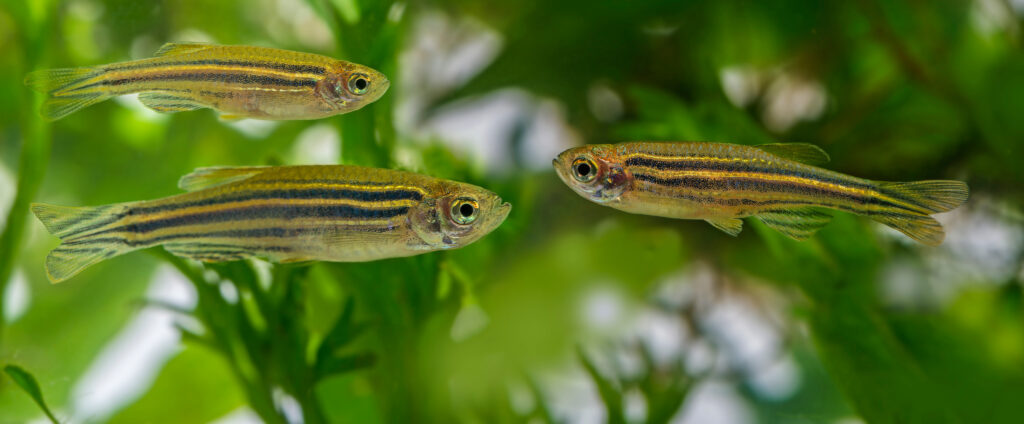
The human body has an incredible capacity for self-repair. Our skin can regenerate after a small cut, bones can heal after fractures and even the liver can regrow to its original size after 70% is lost or removed (3). However, when it comes to the heart, the story is very different. As Miley Cyrus once sang, “nothing breaks like a heart” – and science agrees. Unlike other organs, the heart has almost no ability to regenerate itself after injuries. In instances like myocardial infarctions, more commonly known as heart attacks, large amounts of cardiomyocytes (CMs)—the cells responsible for heart muscle contraction—are lost and cannot be regenerated, causing the formation of non-regenerative fibrotic scar tissue and, ultimately, decline in heart function (1).
But what if research could find a way to change that? Unlike humans, zebrafish possess a remarkable ability to regenerate their hearts after injury. New research published in Nature Cardiovascular Research highlights a protein, Hmga1, as a key player in zebrafish heart regeneration (1). Researchers from the Hubrecht Institute and collaborating institutions explored how Hmga1 can reactivate genes to repair heart damage and tested its potential in mammals through mice studies. Their findings offer hope for future therapies to restore heart function in humans.
Zebrafish: A Model for Heart Regeneration
Unlike human hearts, which form scar tissue after an injury, zebrafish hearts can replace lost muscle cells and fully recover within just 60 days (4). Scientists found this regenerative ability stems from specific genetic and cellular mechanisms reactivated after injury, making zebrafish a promising model for studying regeneration.
Zebrafish are ideal for research due to their genetic similarity to humans, with about 70% of human genes having counterparts in zebrafish. Zebrafish embryos are also transparent, allowing researchers to observe development and regeneration in real time under a microscope. Additionally, their small size, rapid reproduction and ability to produce hundreds of offspring every 10 days make zebrafish especially useful for high-throughput studies (2). These advantages have helped scientists identify key pathways involved in regeneration, including the role of Hmga1 in heart repair.

Testing of Hmga1 in Mammals
In this study, researchers identified Hmga1, an architectural non-histone protein, as critical to zebrafish heart regeneration. Hmga1, active during embryonic development, is reactivated after heart damage in zebrafish to enable key steps in heart repair, as demonstrated by knockout studies showing that zebrafish lacking Hmga1 cannot regenerate heart tissue. Additionally, the protein competes with histone H1, a chromatin-compacting protein, promoting a more open chromatin state. They found this process is accompanied by a reduction in H3K27me3, a repressive histone modification associated with gene silencing. By removing these molecular roadblocks, Hmga1 reactivates genes essential for regeneration, enabling CMs to re-enter the cell cycle and initiate repair—a process confirmed in zebrafish and further tested in mammalian models in this study (1).
To study whether Hmga1 could drive regeneration in mammals, researchers conducted targeted experiments in zebrafish and mice. In zebrafish they used tamoxifen-inducible Hmga1 overexpression to test its sufficiency for regeneration. This provided evidence that it reactivates silenced genes, reducing scar formation and enabling functional heart recovery. In parallel to assess its effects in mammals, the scientists introduced Hmga1 into injured mouse hearts using AAV9-mediated delivery. The results showed that Hmga1 stimulated localized CM proliferation in the injured area of the heart while leaving healthy tissue alone, confirming its potential as a targeted and controlled therapy possible for regeneration (1).
Why This Matters
- Targeted Regeneration: Hmga1 drives regeneration specifically in damaged areas, avoiding risks like uncontrolled proliferation (1). This localized, controlled effect ensures a safer and more effective heart repair strategy.
- Epigenetic Modulation: By removing repressive histone marks like H3K27me3, Hmga1 reactivates silenced genes needed for repair (1). In zebrafish, this mechanism enables cardiomyocytes to re-enter the cell cycle and regenerate heart tissue, offering insights into how similar pathways might be leveraged for human therapies.
- Relevance to Human Health: Millions suffer irreversible heart damage after myocardial infarctions. Regenerating heart tissue could transform patient outcomes, alleviating the global burden of heart failure.
By reactivating silenced genes through epigenetic reprogramming, Hmga1 opens the door to precise and controlled regeneration. Unlike broader strategies that risk side effects like cardiomegaly, this approach confines regenerative activity to the damaged area, offering a safer pathway to repairing the heart.
References
- Bouwman, M., de Bakker, D. E. M., Honkoop, H., Giovou, A. E., Versteeg, D., Boender, A. R., Nguyen, P. D., Slotboom, M., Colquhoun, D., Vigil-Garcia, M., Kooijman, L., Janssen, R., Hooijkaas, I. B., Günthel, M., Visser, K. J., Klerk, M., Zentilin, L., Giacca, M., Kaslin, J., & Boink, G. J. J. (2025). Cross-species comparison reveals that Hmga1 reduces H3K27me3 levels to promote cardiomyocyte proliferation and cardiac regeneration. Nature Cardiovascular Research. https://doi.org/10.1038/s44161-024-00588-9
- Burke, E. (2016, October 14). Why Use Zebrafish to Study Human Diseases? NIH Intramural Research Program. https://irp.nih.gov/blog/post/2016/08/why-use-zebrafish-to-study-human-diseases
- Miyaoka, Y., & Miyajima, A. (2013). To divide or not to divide: revisiting liver regeneration. Cell Division, 8(1), 8. https://doi.org/10.1186/1747-1028-8-8
- Thomas, U. (2025, January 2). Zebrafish Protein Reactivates Repair Genes in Mice to Regenerate Damaged Heart Cells. GEN – Genetic Engineering and Biotechnology News. https://www.genengnews.com/topics/omics/zebrafish-protein-reactivates-repair-genes-in-mice-to-regenerate-damaged-heart-cells/
Latest posts by Shannon Sindermann (see all)
- What 32,000 3D Spheroids Revealed About Culture Conditions - April 15, 2025
- Can Fungi Help Clean Up Environmental Contaminants? - March 20, 2025
- Reprogramming T Cells with DCA: A Metabolic Breakthrough - February 7, 2025
